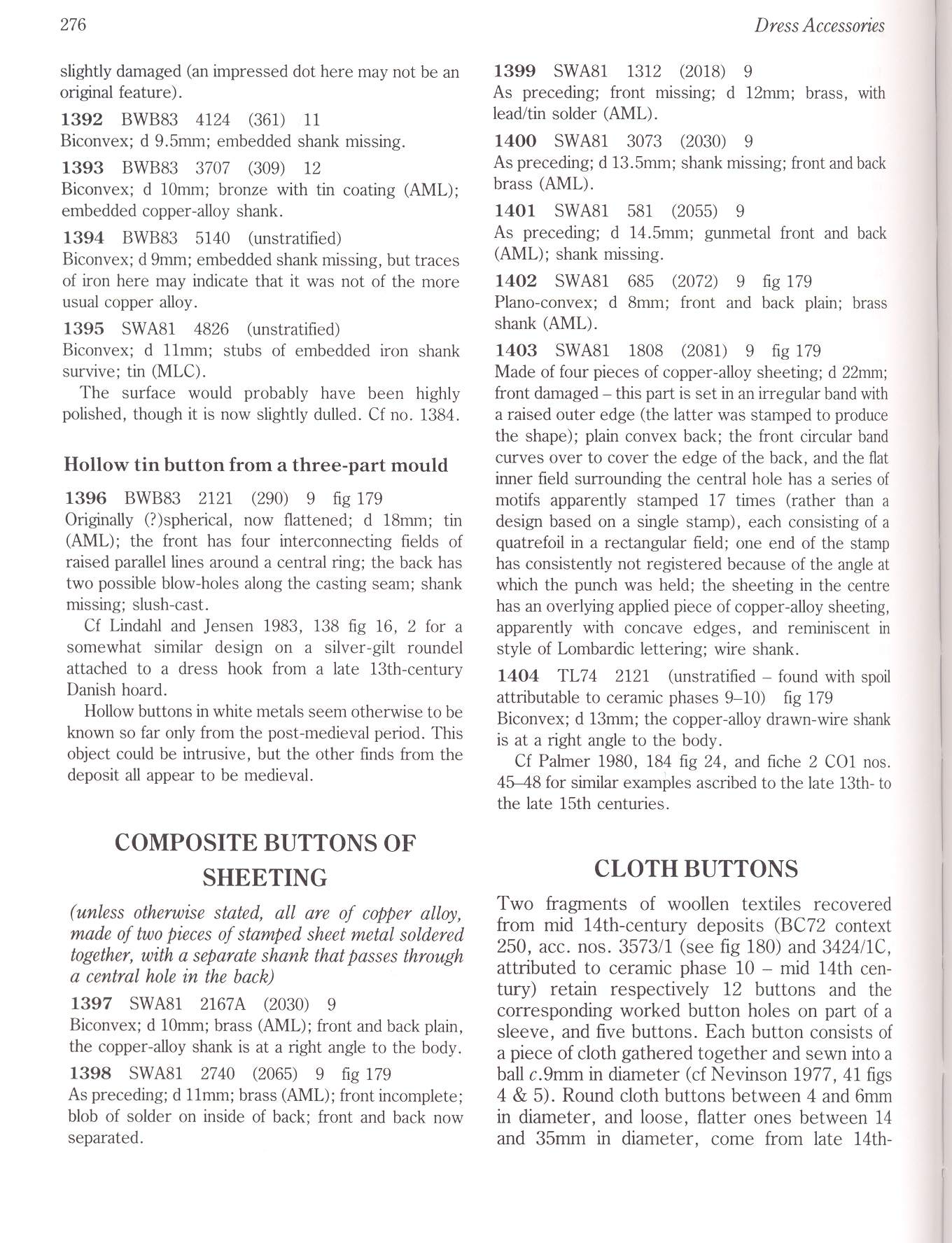304 (37)

276
Dress Accessońes
slightly damaged (an impressed dot here may not be an original feature).
1392 BWB83 4124 (361) 11 Biconvex; d 9.5mm; embedded shank missing.
1393 BWB83 3707 (309) 12
Biconvex; d lOmm; bronze with tin coating (AML); embedded copper-alloy shank.
1394 BWB83 5140 (unstratified)
Biconvex; d 9mm; embedded shank missing, but traces of iron here may indicate that it was not of the morę usual copper alloy.
1395 SWA81 4826 (unstratified)
Biconvex; d llmm; stubs of embedded iron shank survive; tin (MLC).
The surface would probably have been highly polished, though it is now slightly dulled. Cf no. 1384.
Hollow tin button from a three-part mould
1396 BWB83 2121 (290) 9 fig 179 Originally (?)spherical, now flattened; d 18mm; tin (AML); the front has four interconnecting fields of raised parallel lines around a central ring; the back has two possible blow-holes along the casting seam; shank missing; slush-cast.
Cf Lindahl and Jensen 1983, 138 fig 16, 2 for a somewhat similar design on a silver-gilt roundel attached to a dress hook from a late 13th-century Danish hoard.
Hollow buttons in white metals seem otherwise to be known so far only from the post-medieval period. This object could be intrusive, but the other fmds from the deposit all appear to be medieval.
COMPOSITE BUTTONS OF SHEETING
(unless otherwise stated, all are of copper alloy, madę of two pieces of stamped sheet metal soldered together, with a separate shank that passes through a central hole in the back)
1397 SWA81 2167A (2030) 9
Biconvex; d lOmm; brass (AML); front and back plain, the copper-alloy shank is at a right angle to the body.
1398 SWA81 2740 (2065) 9 fig 179
As preceding; d llmm; brass (AML); front incomplete; blob of solder on inside of back; front and back now separated.
1399 SWA81 1312 (2018) 9
As preceding; front missing; d 12mm; brass, with lead/tin solder (AML).
1400 SWA81 3073 (2030) 9
As preceding; d 13.5mm; shank missing; front and back brass (AML).
1401 SWA81 581 (2055) 9
As preceding; d 14.5mm; gunmetal front and back (AML); shank missing.
1402 SWA81 685 (2072) 9 fig 179
Plano-convex; d 8mm; front and back plain; brass shank (AML).
1403 SWA81 1808 (2081) 9 fig 179
Madę of four pieces of copper-alloy sheeting; d 22mm; front damaged - this part is set in an irregular band with a raised outer edge (the latter was stamped to produce the shape); plain convex back; the front circular band curves over to cover the edge of the back, and the fiat inner field surrounding the central hole has a series of motifs apparently stamped 17 times (rather than a design based on a single stamp), each consisting of a quatrefoil in a rectangular field; one end of the stamp has consistently not registered because of the angle at which the punch was held; the sheeting in the centre has an overlying applied piece of copper-alloy sheeting, apparently with concave edges, and reminiscent in style of Lombardie lettering; wire shank.
1404 TL74 2121 (unstratified - found with spoił attributable to ceramic phases 9-10) fig 179 Biconvex; d 13mm; the copper-alloy drawn-wire shank is at a right angle to the body.
Cf Palmer 1980, 184 fig 24, and fiche 2 COl nos. 45-48 for similar examples ascribed to the late 13th- to the late 15th centuries.
CLOTH BUTTONS
Two fragments of woollen textiles recovered from mid 14th-century deposits (BC72 context 250, acc. nos. 3573/1 (see fig 180) and 3424/1C, attributed to ceramic phase 10 - mid 14th cen-tury) retain respectively 12 buttons and the corresponding worked button holes on part of a sleeve, and five buttons. Each button consists of a piece of cloth gathered together and sewn into a bali c.9mm in diameter (cf Nevinson 1977, 41 figs 4 & 5). Round cloth buttons between 4 and 6mm in diameter, and loose, flatter ones between 14 and 35mm in diameter, come from late 14th-
Wyszukiwarka
Podobne podstrony:
292 (37) 264 Dress Accessories 1365 171 Yiolet brooches (drawings 1:1, photograph 2:1) (?)flower bud
296 (37) 268 Dress Accessońes Brooches with circular frames Leaf 1374 BC72 2037 (83) 11 fig 174 Poss
359 (16) 332 Dress Accessońes which to produce a finger ring, it is not a solitary example. Another
15 7 Putting provisions of a contract into practice. Actually, this phase may not be considered as a
It is important that you follow some simple rides when producing an engineering drawing which althou
276 (40) 248 Dress Accessońes because no indication has been recognized on them of the wearer’s adhe
264 (42) 236 Dress Accessońes are fiat (no morę than 0.5mm thick) and are in the form of a disc with
70 (37) Painted Clock You will need an 8" sqtiare wo*xlen clock frame with insert. clock moveme
274 (42) Dress Accessońes 246 1078 805 1095 (A) mounts with fields of dots (1:1) (
278 (40) 250 Dress Accessories 1314 1311 SWA81 2186 (2055) 9 fig 160 Corroded
284 (41) 256 Dress Accessońes Hooked annular brooch Copper alloy 1338 SWA81 acc. no. 1493 (context
286 (34) 258 Dress Accessońes 166 Pentagonal, hexagonal and six-lobed brooches -odginał shapes resto
298 (39) 270 Dress Accessories Table 5 Brooches - metals used 1 1 Copper i i 2 I I I -1-1—[— 1 1 1
302 (41) 274 Dress Accessońes buttons of the former kind, found in Lund in Sweden). Composite sheeti
306 (35) 180 180 278 Dress Accessońes Cloth buttons and corresponding holes on a sleeve from a depos
308 (39) 280 Dress Accessońes late 13th century onwards. The alloys used in buttons prior to that co
310 (36) 282 182 Lace chapes: terminology Dress Accessories O edge to edge seam overlapping seam end
312 (36) 284 Dress Accessories O /v- <& © - O 1428 1406 0 184 Lace chapes (1:1) 1426
więcej podobnych podstron